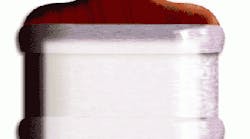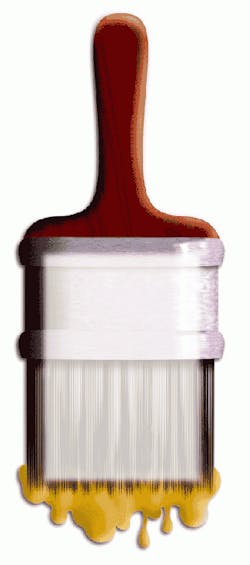Fluoride doesn't often make headlines anymore. It's been around a long time, and its clinical usefulness has been proven over and over again. We all take it for granted. So maybe it's a stretch to get excited about another new fluoride product, but fluoride varnish is worth noting.
If you think fluoride varnish sounds more like something to refinish your wood floor, think again. Although still in its beginning stages of acceptance in the United States, fluoride varnish has been used as a caries preventive for years in Europe and Canada, and a mountain of evidence reveals its effectiveness.
Fluoride varnish is usually a caramel-colored, viscous semiliquid that is brushed on teeth. Most formulations are basically a 5 percent sodium fluoride in a sticky colophon or resin base, with alcohol to make the product dry quickly on the teeth. The stickiness helps the product adhere to the teeth as well as flow into fissures and interproximal areas with fairly precise control.
To date, the FDA approves fluoride varnish use as a cavity liner and desensitizer, but not as a caries preventive. Hypersensitive cervical and gingival recession areas are already benefiting from varnish application, and caries prevention could be next if adequate clinical trials prove the product's effectiveness. For now, its use as a cavity-preventive treatment is considered "off-label."
So, is it dangerous to use a fluoride varnish as a cavity preventive? The evidence seems to say "no." One formulation has been used in Europe and Scandinavia for more than 25 years as a caries preventive and has significant clinical studies to demonstrate its effectiveness. The ADA has granted its coveted Seal of Approval to a fluoride varnish, although this can't be printed on the label until approved by the FDA as a caries preventive. Medicaid programs in Washington and North Carolina consider fluoride varnish a covered service. Some public health programs are using fluoride varnishes on infants and very young children to help prevent rampant decay. Even though the fluoride concentration of some varnishes is about two times greater than typical APF gel or foam, studies show that the fluoride blood level after varnish application is substantially less than APF or neutral fluoride, which means less fluoride is being ingested during treatment.
Dr. James Bawden, former dean of the dental school at the University of North Carolina, writes in the Journal of Public Health Dentistry (fall 1998) that when "off-label use becomes common, it becomes 'the standard of care in practice.' " According to an article in Pediatric Dentistry (2000), fluoride varnishes are "fast becoming the standard of care as topical fluoride treatments."
Four companies currently manufacture fluoride varnish: Colgate (Duraphat), Omnii Oral Pharma ceuticals (Cavity Shield), Medicom (Durafluor), and Ivoclar (Fluor Protector). Each product has similarities, but may have differences in formulation, delivery of product, and amount of clinical research. Cost per application of varnishes ranges from $.77 to $4.
Always follow the manufacturer's directions for application of a particular product. However, the steps to use fluoride varnish are generally similar. A very thin layer of varnish is applied to clean, dry teeth with a brush or applicator. It is important not to overapply the product because of fluoride ingestion and toxicity concerns. The varnish dries almost instantly to a dull, yellowish film. Floss can be used to pull the product further into interproximal areas if needed. The patient is advised to eat a soft diet the rest of the day, temporarily discontinue any fluoride supplements (if applicable), and wait several hours before brushing off the product. Fluoride varnish has been shown to remain several weeks in deep fissure areas.
Kevin Thomas, CEO of Omnii Oral Pharmaceuticals (formerly Omnii Products), said his company began in the preventive-care business with stannous fluoride products and was looking for new technology on the fluoride scene. He said they felt fluoride varnish would be a big product in the future, so they put their product development and research team to work on the formulation.
"We see many practical uses for fluoride varnish," said Thomas. "Fluoride varnish may be a good way to help protect the 'third dentition' of the geriatric patient from root caries," said Thomas, "especially in nursing homes and assisted-living situations where there is low dental activity. There is a significant rise in root caries due to the aging population keeping more of their teeth and medications causing xerostomia. Another unique use is in pediatric dentistry. If a child needs an MOD restoration on a molar, there is a high likelihood that the mesial and distal contact of the opposing teeth will have some decalcification. Some dentists are painting on fluoride varnish after the prep in those proximal contacts to protect those decalcified areas. Another great use for varnish is to paint some under the flap of a partially erupted six- or 12-year molar. There is no sealant ability until it fully erupts and the varnish can get down into the fissures. Two weeks later, there is evidence that the varnish is still in the crevices of the molar."
Mr. Thomas was careful to state that his views regarding fluoride varnish are formed from feedback from educators and practitioners with practical experience with the product, as well as published professional articles, and does not label claims they promote for the product.
Dr. Fiona Collins, director of professional relations for Colgate Oral Pharmaceuticals, lists several factors to consider when selecting a fluoride varnish. "First and foremost, look at the clinical and safety data of the product for evidence-based dentistry. Does it have a history of clinically proven, effective use? Is there substantial clinical data to back up the claims?"
Dr. Collins suggests that prime advantages of fluoride varnish are ease of application and taste. Other advantages cited in professional literature include:
- No suction or trays are needed with application.
- You can easily target one area for application.
- It enhances remineralization of the tooth surface.
Varnish holds great promise for orthodontic applications; it appears not to affect the bonding ability of brackets after treatment.
Personal clinical experiences
I have used several different fluoride-varnish products in practice for several months. The cost is very competitive with APF gel/foam products, because we no longer need the tray. Patient acceptance of the product has been extremely positive. In a completely unscientific survey, I ask patients after treatment which fluoride treatment they prefer: fluoride in trays or varnish. About nine out of 10 patients claim to prefer the varnish. Most patients are happy with the lack of taste and the ability to drink water immediately after treatment. Parents of treated children seem to like being able to actually see the fluoride on the teeth. The product does easily brush off, although floss may be needed to clean interproximal areas.
Some teenagers have objected to the slight yellow coloring on their teeth, and one parent protested because he thought the yellow coloring was from a poorly performed prophy and should have been cleaned off. Consequently, it is important to explain the behavior of the product and assure the parent and patient that the yellowish color is only temporary and will brush off easily.
I have found that keeping a thin, even film can be a challenge, since most of the products are very viscous. It helps not to overload the brush when applying. It also can be a bit tricky to decide how much product to use on a particular patient, especially when dispensing from a tube or bottle. I personally found the unit-dosed product easier to use, because the exact varnish amount is prepackaged and a brush is included.
The product is very sticky, so avoid touching the lips or face with the brush. A quick wipe of the lips with petrolatum or lip balm prior to treatment is helpful. If varnish gets on the face or lips, try rubbing lightly with a 2 x 2 gauze soaked with alcohol-based mouthwash. If varnish gets on the instruments or mirror, simply wipe off or remove with alcohol. Don't autoclave instruments with varnish or the stuff bakes on and becomes very difficult to scrape off.
Cathleen Terhune Alty, RDH, is a frequent contributor to RDH. She is based in Clarkston, Mich.







